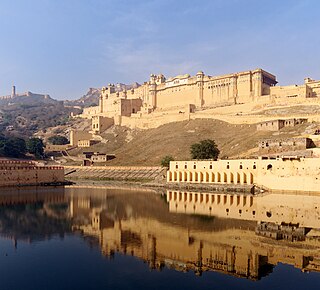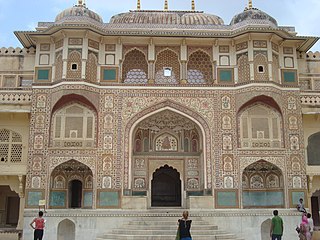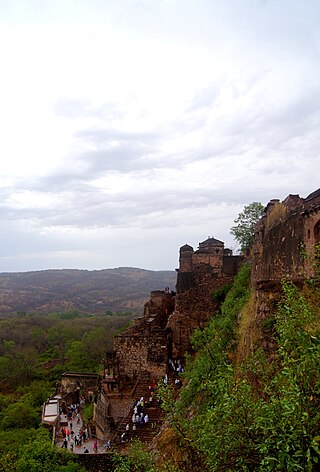Related Research Articles

Rajasthan is a state in northwestern India. It covers 342,239 square kilometres (132,139 sq mi) or 10.4 per cent of India's total geographical area. It is the largest Indian state by area and the seventh largest by population. It is on India's northwestern side, where it comprises most of the wide and inhospitable Thar Desert and shares a border with the Pakistani provinces of Punjab to the northwest and Sindh to the west, along the Sutlej-Indus River valley. It is bordered by five other Indian states: Punjab to the north; Haryana and Uttar Pradesh to the northeast; Madhya Pradesh to the southeast; and Gujarat to the southwest. Its geographical location is 23°.3' to 30°.12' North latitude and 69°.30' to 78°.17' East longitude, with the Tropic of Cancer passing through its southernmost tip.

Amber or Amer, is a city near Jaipur city in Jaipur district in the Indian state of Rajasthan. It is now a part of the Jaipur Municipal Corporation.

Meena is a tribe from northern and western India which is sometimes considered a sub-group of the Bhil community. It used to be claimed they speak Mina language, a spurious language. Its name is also transliterated as Meenanda or Mina. They got the status of Scheduled Tribe by the Government of India in 1954.

The Kachhwaha, or Kushwaha is a Rajput clan found primarily in India.

Dhundhar, also known as Jaipur region, is a historical region of Rajasthan state in western India. It includes the districts of Jaipur, Neem ka Thana, Dantaramgarh part of Sikar District lying to the east of the Aravalli Range, Dausa, Sawai Madhopur, Tonk, the southern part of Kotputli and the northern part of Karauli District.

Amer Fort or Amber Fort is a fort located in Amer, Rajasthan, India. Amer is a town with an area of 4 square kilometres (1.5 sq mi) located 11 kilometres (6.8 mi) from Jaipur, the capital of Rajasthan. Located high on a hill, it is the principal tourist attraction in Jaipur. Amer Fort is known for its artistic style elements. With its large ramparts and series of gates and cobbled paths, the fort overlooks Maota Lake, which is the main source of water for the Amer Palace.

Jaipur District is a district in the state of Rajasthan in Northern India.the city of Jaipur, which is Rajasthan's capital and the largest city, is the district headquarters. It is the tenth most populous district in India.

Dausa district is a district in the Indian state of Rajasthan. It is part of the Jaipur division–one of the ten administrative divisions of Rajasthan. The city of Dausa is the district headquarters. Other important cities are Bandikui, Lalsot, and Mahuwa. It is surrounded by Alwar district in the north, Bharatpur in the east, Gangapur in the south-east, Sawai Madhopur in the south, and Jaipur Rural in the west. It has an area of 3,432 km2 (1,325 sq mi) and a population of 1,634,409.

Shahpura is a town and a municipality, near city of Jaipur in Jaipur Rural district in the Indian state of Rajasthan.
Todabhim is a city and a "municipality" in Gangapur City district in the Indian state of Rajasthan. It is headquarters of Todabhim sub division, tehsil and C&RD block of Gangapur City district.

The Kingdom of Amber, later the Kingdom of Jaipur or the Jaipur State, was located in the north-eastern historic Dhundhar region of Rajputana and was ruled by the Kachwaha Rajput clan. It was established by Dulha Rai, possibly the last ruler of the Kachchhapaghata dynasty of Gwalior who migrated to Dausa and started his kingdom there with the support of Chahamanas of Shakambhari in the 12th century. Mostly through 12th to 15th century, the kingdom faced stagnation, sources were scarce. Under its ruler, Raja Chandrasen of Amber became a Sisodia vassal and fought in the Battle of Khanwa under Raja Prithviraj Kachhwaha.

Ranthambore Fort lies within the Ranthambore National Park, near the city of Sawai Madhopur in Sawai Madhopur district of Rajasthan, India. the park being the former hunting grounds of the Maharajahs of Jaipur until the time of India's Independence. It is a formidable fort having been a focal point of the historical developments of Rajasthan. The fort was constructed by Nagil Jat ruler Raja Sajraj Singh Nagil and later captured by several Rajput dynasties including Hada and Mewar and then the Delhi Sultanate captured it for a brief time. The fort provides a panoramic view of the surrounding Ranthambore National Park and is now a popular tourist attraction.

Galtaji is an ancient Hindu pilgrimage about 10 km away from Jaipur, in the Indian state of Rajasthan. The site consists of a series of temples built into a narrow crevice in the ring of hills that surrounds Jaipur. A natural spring emerges high on the hill and flows downward, filling a series of sacred kunds in which pilgrims bathe. Visitors and pilgrims can ascend the crevasse, continuing past the highest water pool to a hilltop temple from there are views of Jaipur and its fortifications spreads out across the valley floor. It is believed that a Saint named Galav lived here, practiced meditation, and did penance (tapasya).
Rajasthani people or Rajasthanis are a group of Indo-Aryan peoples native to Rajasthan, a state in Northern India. Their language, Rajasthani, is a part of the western group of Indo-Aryan languages.

Hill Forts of Rajasthan are six forts, spread across Rajasthan state in northern India. They have been clustered as a series and designated as a UNESCO World Heritage Site in 2013. The hill forts series include—Chittor Fort at Chittorgarh, Kumbhalgarh Fort at Rajsamand, Ranthambore Fort at Sawai Madhopur, Gagron Fort at Jhalawar, Amer Fort at Jaipur and Jaisalmer Fort at Jaisalmer.
Kakil or Kankil was a king of the Kachhwaha dynasty and successor of Dulha Rai, who ruled the Dhundhar region with their capital at Khoh in present-day Rajasthan.
Jhotwara is a suburban area of Jaipur in the north-west direction of Jaipur, the capital of Indian State of Rajasthan. It is a Legislative Assembly constituency

Sri Narasimha Temple, Amber is located in Amber, Jaipur, India. It is situated near to the down side of the Amber Fort. Sri Narasimha temple is in the first and old Amber palace used by the Kachhwaha Queens and Kings of Amber. Originally, it was used by the Meena Queens and Kings of Susavata dynasty. Sri Narasimha Temple, Amber is known for its historical story and not its architecture.
Khoh, also known as Khogong, was the capital of the kingdom of Amber which was located in the Dhundhar region of Rajputana. Which was located just five miles to the east of Jaipur city and was ruled by the Chanda clan. Rao Chandrasen Chanda abandoned Mahishmati city and established a kingdom here. It was the capital of the Chandas till the 11th century and of the Kachhawahas from the 11th to the 13th century.
Dulha Rai was the founder of the Kachhwaha dynasty and also the 1st king from this dynasty who ruled the territory of Dhundhar, with his capital at Khoh in present-day Rajasthan. He started his rule from Dausa which he obtained as a dowry from the Chahamanas of Shakambhari. Making Dausa as his base, he started conquering the region of Dhundhar and soon was recognised as the ruler of this region by the Chahamanas after he successfully suppressed the rebellious Bargujar Rajputs.
References
- ↑ Sarkar, Jadunath (1994) [1984]. A History of Jaipur: C. 1503–1938. Orient Longman Limited. pp. 23, 24. ISBN 81-250-0333-9.
- ↑ Census of India, 1981: District census handbook. A & B, Village & town directory ; Village & townwise primary census abstract. 1983. p. XXl,19.
- ↑ Jaipur: Gem of India. IntegralDMS, 2016. 7 July 2016. p. 30. ISBN 9781942322054.
- ↑ Rima Hooja (2006). A history of Rajasthan. Rupa & Co. p. 396. ISBN 9788129108906. OCLC 80362053.